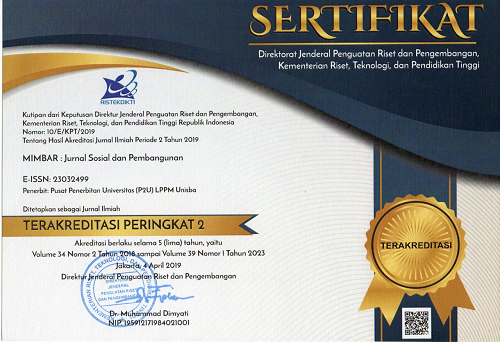Climate Change and Agricultural Adaptation in Indonesia
Abstract
This research strives to provide answers regarding adaptation patterns of farmers in confronting climate change in Indonesia. The method utilized for this research is a mixed method. Qualitative data was acquired through a series of focus group discussions and in-depth interviews with farmers and agricultural stakeholders in Gunung Kidul and Sleman, Indonesia. Additionally, the survey was carried out to 220 farmers in both research locations. The two research locations were chosen based on the difference in agricultural land. The findings of this research show that farmers understand climate change is occurring in their region and it influences their cultivation method. Farmers utilize their personal experiences as well as local practices in adapting to climate change. The impact most felt by farmers is crop failure and a decrease in quality and quantity of agricultural crops. The ensuing implication is that farmer’s income declines more and more. This research found that agricultural product cost increased by almost as much as 50%, whilst farmer’s income merely increased half of that, which is 25% since climate change has affected their farming. Responding to the matter, the strategy farmers employ is by changing the planting pattern, using soil cultivation technique, plant pest management technique, and watering/irrigation technique.
Keywords
Full Text:
PDFReferences
Adger, W. N., Huq, S., Brown, K., Conway, D., & Hulmeet, M. (2003). Adaptation to Climate Change in the Developing World. Progress in Development Studies, 3(3), 179-195.
Al-Gamal, S. A., Sokona, Y., & Abdel-Kader, D. (2009). Climate Changes and Ground Water Resources in Africa. International Journal of Climate Change, Strategies and Management, 1(2), 133-145.
Choudri, B. S., Al-Busaidi, A., & Ahmed, M. (2013). Climate Change, Vulnerability and Adaptation Experiences of Farmers in Al-Suwayq Wilayat, Sultanate of Oman. International Journal of Climate Change, Strategies and Management, 5(4), 445-454.
Cornish, G. A. (1998). Modern Irrigation Technologies for Smallholders in Developing Countries. London: Intermediate Technology.
Crate, S. A., & Nuttall, M. (2009). Introduction: Anthropology and Climate Change. In S. A. Crate & M. Nuttall (Eds.), Anthropology and Climate Change: From Encounters to Actions. California: Walnut Creek.
Creswell, J. W. (1994). Research Design: Qualitative and Quantitative Approaches. Thousand Oaks, CA: Sage Publications.
Ellis, F. (2000). Rural Livelihoods and Diversity in Developing Countries. Oxford: Oxford University Press.
Frankhauser, S., & Tol, R. S. J. (1996). Climate Change Costs: Recent Advancements in the Economic Assessment. Energy Policy, 24(7), 665-673.
Howe, K. R. (2004). A Critique of Experimentalism. Qualitative Inquiry(10), 42-61.
IPCC. (2001). Climate Change 2001: Impact, Adaptation, Vulnerability Contribution of Working Group II to the Third Assessment Report of the Intergovernmental Panel on Climate Change. Geneva: UNEP/WMO.
IPCC. (2007a). Climate Change 2007: Impacts, Adaptation and Vulnerability. New York: Cambridge University Press.
IPCC. (2007c). Climate Change 2007: The Physical Science Basis. New York: Cambridge University Press.
Jafry, T. (2012). Global Trade and Climate Change Challenges: A Brief Overview of Impacts on Food Security and Gender Issues. International Journal of Climate Change, Strategies and Management, 4(4), 442-451.
Manne, A., Mendelsohn, R., & Richels, R. (1995). MERGE - A Model for Evaluating Regional and Global Effects of GHG Reduction Policies. Energy Policy, 23(1), 17-34.
Matarira, C. H., Pullanikkatil, D., Kaseke, T., Shava, E., & Mantsa, D. (2013). Socio-Economic Impacts of Climate Change on Subsistence Communities: Some Observations from Lesotho. International Journal of Climate Change, Strategies and Management, 5(4), 404-417.
Murad, M. W., Molla, R. I., Mokhtar, M. B., & Raquib, M. A. (2010). Climate Change and Agricultural Growth: An Examination of the Link in Malaysia. International Journal of Climate Change, Strategies and Management, 2(4), 403-417.
Roncoli, C., Ingram, K., Jost, C., Kirshen, P., & Orlove, B. (2003). Meteorological Meanings: Farmers’ Interpretation of Seasonal Rainfall Forecast in Burkina Faso. In S. Strauss & B. Orlove (Eds.), Weather, Climate, Culture (pp. 181-200). Oxford and New York: Berg.
Smit, B., & Wandel, J. (2006). Adaptation, Adaptive Capacity and Vulnerability. Global Environmental Change, 16, 289-292.
Stehr, N., & Storch, H. V. (2005). Introduction to Papers on Mitigation and Adaptation Strategies for Climate Change: Protecting Nature from Society or Protecting Society from Nature? . Environmental Science & Policy, 8(6), 537-540.
Suroso, D. S. A., Hadi, T. W., & Salim, W. (2009). Indonesia Climate Change Sectoral Roadmap (ICCSR). Jakarta, Indonesia: National Development Planning Agency.
Tompkins, E. L., & Neil Adger, W. (2005). Defining Response Capacity to Enhance Climate Change Policy. Environmental Science & Policy, 8(6), 562-571.
Winarto, Y. T., & Stigter, K. (Eds.). (2011). Agrometeorological Learning: Coping Better with Climate Change. Saarbrücken: Lambert Academic Publishing
DOI: https://doi.org/10.29313/mimbar.v32i2.1841
Refbacks
- There are currently no refbacks.
MIMBAR : Jurnal Sosial dan Pembangunan is licensed under Creative Commons Attribution-NonCommercial-ShareAlike 4.0 International License.















